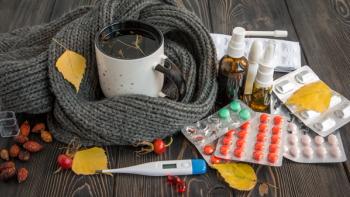
Finding the Right Treatment for Managing Your Acne
Patients should understand how to use OTC and prescription medications that treat acne and follow preventive measures to reduce acne flare-ups or prevent this common dermatologic condition.
Ms. Terrie is a clinical pharmacy writer based in Haymarket, Virginia.
Acne is one of the most common dermatologic conditions, affecting millions of individuals in the United States. Acne is characterized by whiteheads, blackheads, and blemishes. In general, acne typically develops primarily in teenagers; however, many adults have some degree of acne as well.
The exact cause of acne is unknown. Hormonal changes during the teenage years, as well as during pregnancy may be contributing factors. In general, there are 2 types of acne:
1. Noninflammatory acne—characterized by the presence of whiteheads and blackheads.
2. Inflammatory acne—characterized by the presence of pimples, which may rupture to form inflammatory lesions that are raised, reddened areas on the skin called “papules.”
In the majority of acne cases, individuals exhibit both types of acne. Acne typically occurs in the facial area, chest, and back, where the sebaceous glands are the most prominent. Acne can also occur on other areas of the body as well, such as on the neck and upper arms.
Causes of Acne
There are a variety of factors that may contribute to or worsen acne. These factors can be classified as environmental, physical, or emotional. Examples of these factors include:
â– Oil-based cosmetic use
â– Stress and anxiety
â– Humidity or exposure to dirt
â– Premenstrual changes or hormonal changes
â– Physical irritation from occlusive clothing, headbands, hats, helmets, etc
â– Use of certain medications, such as phenytoin, isoniazid, phenobarbital, lithium, quinine, rifampin, and steroids
Treating Acne
In general, the goals of acne treatment are to prevent or minimize the incidence of pimples and prevent scarring. Early treatment is best to avoid scarring. The treatment selected for acne is dependent upon the type of acne and the severity of the acne.
Your doctor may suggest the use of one of the various topical over-the-counter products available for the management of mild-to-moderate cases of acne. In most cases, selftreatment is appropriate for mild acne cases and can be easily managed and controlled by following a daily skin care regimen and avoiding factors that may worsen acne flare-ups.
Currently, there are a variety of nonprescription skin care products available for the self-treatment of mild-to-moderate cases of acne. These products are available as medicated cleansing bars, liquids, lotions, creams, gels, and pads/wipes, and they typically contain at least 1 of the following ingredients: benzoyl peroxide, salicylic acid, sulfur with or without resorcinol, and sulfur with sodium sulfacetamide.
Benzoyl peroxide
Benzoyl peroxide is considered to be the most effective and widely used nonprescription medication for both types of acne. Benzoyl peroxide kills Propionibacterium acnes (P acnes), which is the bacteria that causes acne inflammation. This medication helps to remove excess oils from the skin, as well as remove dead skin cells that clog pores. Benzoyl peroxide may cause excessive dryness of the skin, burning, and tingling. Caution should be used when applying to areas near the lips, nose, and mouth, as well as areas with open scrapes or cuts. In addition, contact of benzoyl peroxide with hair and clothing should be avoided, since it may cause bleaching. You should continue treatment for at least 4 to 6 weeks and seek medical advice if there is no improvement or if acne worsens after 6 weeks of therapy.
Salicylic acid
Salicylic acid decreases the shedding of cells inside the hair follicles, which prevents clogged pores. This medication is often found in many acne facial washes and cleansers as well as gels and creams. Salicylic acid may cause burning, stinging, and redness of the skin.
Sulfur
Sulfur is thought to treat acne by preventing the growth of P acnes, and may also help to remove dead skin cells and excess oil. It is often found in combination with resorcinol or sulfacetamide. Its use may cause dryness, redness, and peeling of the skin. The use of sulfur products is often limited because of the chalky yellow color and noticeable odor. Products containing resorcinol may cause a reversible dark scaling on those individuals with darker skin tones.
It is important to use these products as directed and adhere to the selected treatment regimen. If you experience any adverse reactions due to any of these products, you should discontinue their use immediately and contact your primary health care provider.
If your acne shows no signs of improvement or worsens after regular use of these products, you should consider consulting a dermatologist to discuss other treatment options or recommendations for your acne.
If you have a moderate-to-severe case of acne, you should always seek medical care for evaluation to avoid further complications. Your doctor may prescribe a prescription product, either an oral or a topical medication, to treat your acne. In some cases, your doctor may suggest a combination of treatments. Since some medications should not be used during pregnancy, it is important to inform your doctor if you are pregnant, breast feeding, or planning to become pregnant.
Prior to prescribing any medications for acne treatment, your doctor will obtain a full medical, allergy, and medication history to prevent any possible contraindications or drug interactions. It is important to adhere to the recommended treatment for the medication to be effective, especially since it may take several weeks to see any signs of improvement. You should always discuss any concerns about your treatment with your physician or pharmacist, and be sure that you clearly understand how to use your medication and the side effects associated with its use.
Newsletter
Stay informed on drug updates, treatment guidelines, and pharmacy practice trends—subscribe to Pharmacy Times for weekly clinical insights.














































































































































































































